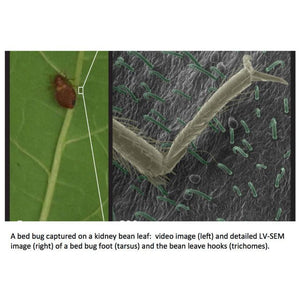Trapping Bed Bugs with Bean Leaves
Recently we wrote about pesticide resistance in bed bugs. A group of scientists is exploring a way to circumvent that resistance by mechanically trapping bed bugs through mimicking an old folk remedy: kidney bean leaves. Here is the scientific paper. And here is a New York Times article on this research.
Long ago, in Eastern Europe, bean leaves would be spread on the floor at night. Bed bugs would walk across the leaves and get stuck. The next morning, the leaves with attached bed bugs would be swept up and burned.
The leaves are not sticky—so that is not what is trapping the bed bugs. Rather, the leaves have tiny “trichombs”—hair-like hooks—that puncture a weak portion of the exoskeleton on the bed bugs legs and trap the bed bug. It is remarkably effective. Here is a slow motion video showing a bed bug getting stuck on a bean leaf.
The researchers replicated these miniscule trichombs, using various polymers. To quote the scientists: “The moulding process generated synthetic trichombs that were identical to the natural trichombs, with the proper aspect ratio and sharpness of tips, arranged with the same density, orientation and height seen on natural leaves.”
Despite being so similar, the artificial trichombsdid not trap the bed bugs nearly as well as the natural leaves.
The scientists even tried a hybrid combination with a natural leaf trichomb tip but an artificial tricomb stalk, which also proved ineffective.
Why would this be? “This surprising result,” the researchers write, “…suggests that the bending or twisting behaviour of the trichome stalks is crucial to guide piercing and is not yet exhibited by our fabricated surfaces.”
Given that there is no known evolutionary connection between the natural bean leaf and bed bugs, it is remarkable that the bean leaves are so effective at trapping bed bugs.
The researchers are not giving up and hope to eventually develop a synthetic trichombs that are as effective as the bean leaf trichombs.
Posted by Andrew Havlis


